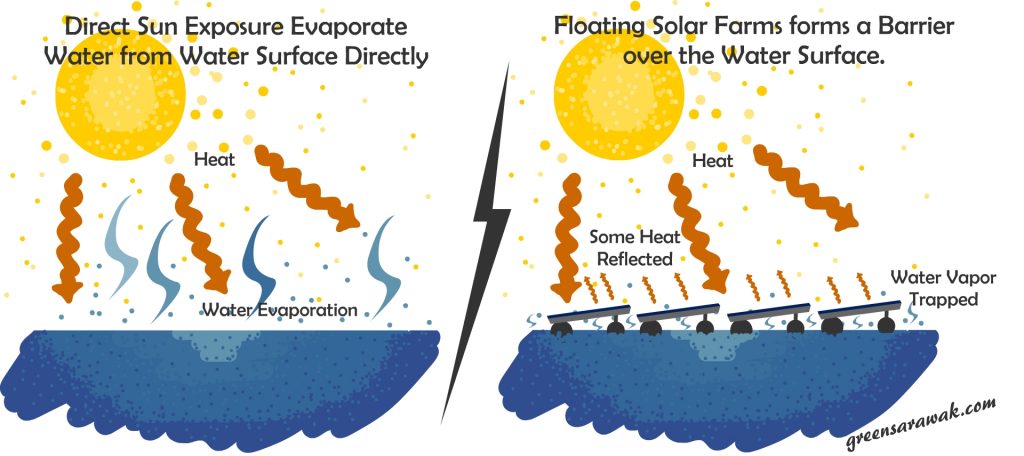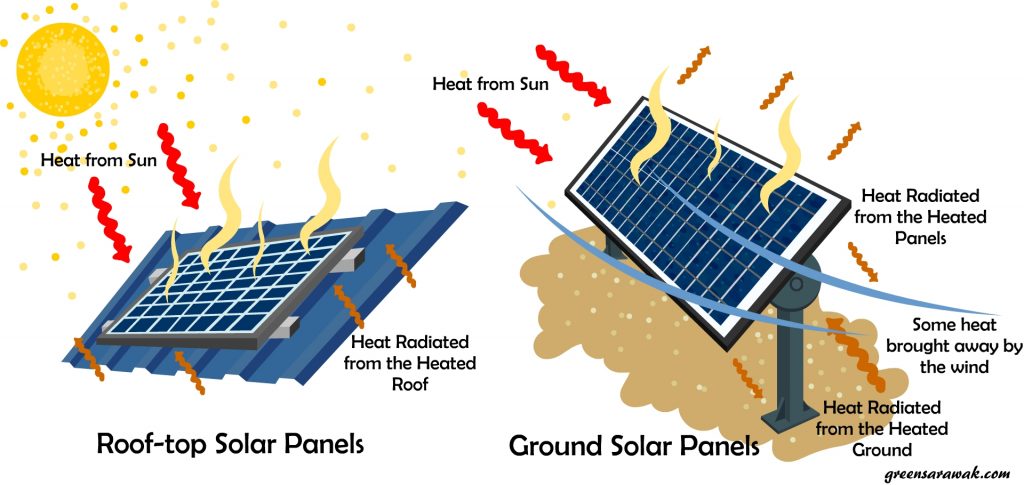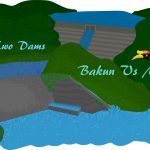Solar Photovoltaic or generally known as Solar Power, is a green technology that allow the harvest of unlimited Sun Rays into Electricity power. It is the core of the Renewable Energy Movement around the globe. Many successful installation of Solar PV power stations around the world had mark its success.
The simplicity of solar power had made it easy to implement in small and large scale power generation project. The prerequisite of having a Solar PV farm is to have a space that have a good contact with sunlight, which including any open space from open desert, open field , on top of buildings and vehicles, with currently includes the Open body of water (river and sea).
Recently the Sarawak Chief Minister Datuk Patinggi Abang Johari Tun Openg has thrown a proposal to the LONGi Group of China (first integrated photovoltaic manufacturing base in a single location producing Mono Crystalline silicon ingots, wafers, cells and modules) to explore the possibility of developing floating solar parks at dams and rivers in the state.
Electricity is the technology and sector that is too big to fail in this modern world as we are dependent on electricity to run most part of our cities utility, transportation, daily routines and personal gadget. Lets find out how floating solar farms can be the next alternative in our quest for greener energy.
The Global Movement into floating Solar Farms
Floating Solar Farms is also known as Floating Solar Array, Floating Solar Systems or Floatovoltaics.
Floating solar farm is not a new idea either. However due to its benefit of Floating Solar PV in compare with other placement of Solar PV (which will be discussed below), it had slowly gain popularity in China, India, the United Kingdom, and Japan, where there is limited roof and/or ground space available for installations.
Prior to 2014, there is only three floating solar farms that had gone online, however in past three years the number of successful installation and capacity are raising around the globe with more than 100 plants are going online. Approximately 80% of the top 70 floating solar farms are located in Japan.
China is actively involve in floating solar farms installation, with the world’s Top 3 largest floating solar is all belongs to China (as of early 2018). Currently the Largest Floating solar farm is 40 MW massive floating solar farm on top of an abandoned coal mine in China (Anhui province near the city of Huainan), with larger floating solar farm is still in construction.
Floating solar farm is still currently much dwaft in comparison to the even larger Land Based solar farm. The world largest land based solar farm falls to Tengger Desert Solar Park in China with 1,547 MW installed capacity on a 43 Kilometer square of land.
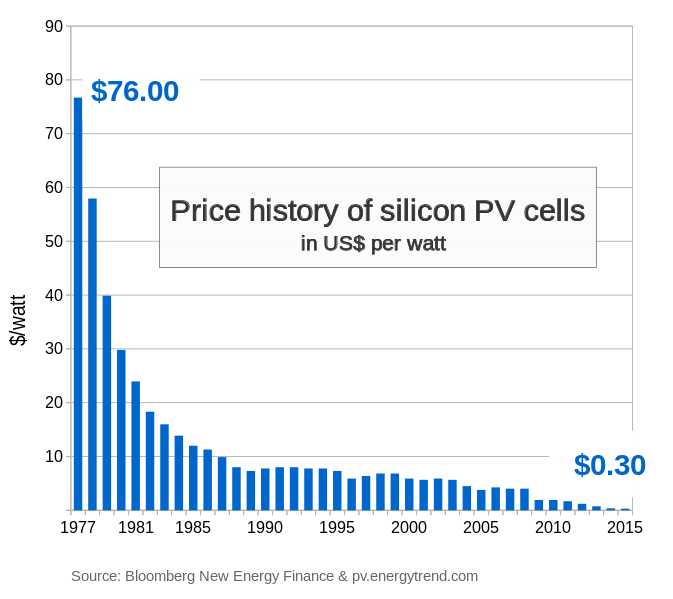
Source: Bloomberg, New Energy Finance & EnergyTrend.com
With the dropping of the price of silicon photovoltaics cells, the cost of ownership of a Solar Power facility is going to drop and become more affordable, in some area of the world, the cost to generate power from Solar had been drop to a level similar to the cost to generate power from traditional fossil fuels. It is a matter of time before the question of where to place a Solar Farm becomes more relevant than the question of will Solar Power cheaper than fossil fuel.

The Basic of Solar PV Power Generation
Before having another lengthy post of the Basic of Solar PV power generation, please look at our another article : A Quick Look in things to know before going Solar
The concept of Solar PV power generation is very simple. A light source with a sufficient energy hitting on a Photovoltaic material (solar cell) will cause the movement of electron, which adequate number of Solar Cells will work together to generate enough voltage to run a load, inverter or other devices.
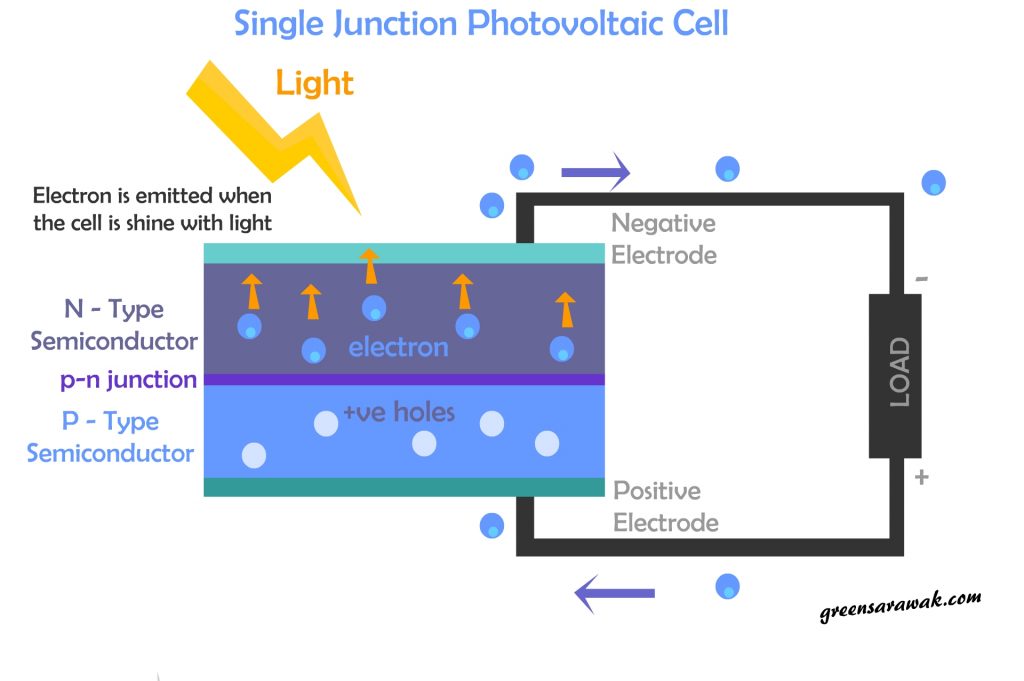
To ensure a good solar to electricity efficiency, the solar cells must face the light source (the sun) if possible all times without issues of shading. There will be gain in efficiency if the solar cells is cool down.

The concept of cooling down solar cells during power generation have led to development of floating solar farms as the evaporation and condensation of water from the water body can have significant cooling effects on the solar cells.
Solar PV installations – Ground or Water type ?
Ground based solar PV installations had been the tradition in solar PV installations, as it is easily scaled up as long as there is ground to spare. In most habitable places, towns and cities, the land value will be too much to spend for solar farm building. Currently massive solar farms are located in the desert with miles and miles of vast inhabited land and a good source of sunlight. However desert storms can be unpredictable, which can up root solar panels and cover the panels with thick sand dust that reduces its efficiency. In some country, unused golf course and plains is used for solar panel installations, but when land is getting more scares and limited, those land will still be reclaimed for city expansion later.
With solar tariffs available to homes and buildings installation of solar panel, including the net metering and Feed In Tariff, the installation of roof top solar panels and building integrated solar panels are also on the raise. However due to other issues like limited optimal installation place, and expensive up front cost of installation, there is still many roofs are spared from solar panels. In ever growing cities, you will never know when will be the next sky scrapper project around your neighborhood that will shade your panels in the future.
Hence the new kind of solar farms are raising slowly, the floating solar farms. The concept is to build the space consuming solar farm on water body like river, reservoirs, lakes and sea. These water body are wide un-shaded area which is un-habited (as of now, very minority people will build houses and quarters on or in the water body). It is perfect for floating solar farm, but with a cache – solar panels don’t float on water, you will still need a long lasting flotation device below the panels to hold them.
Building a Floating Solar Farm
Building a floating solar farm is as easy as it may sound – A solar farms that floats – but the technical aspects can be complex in sense that the floating solar farms must kept afloat for decades without the costly panels sinking into the bottom of the lake or river.
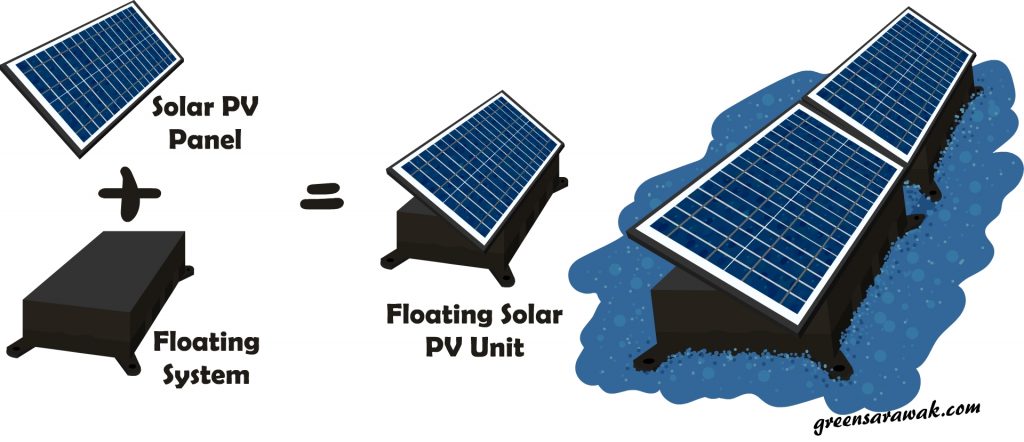
You still can have a personal floating solar farm build with solar panels strap to a wooden raft, or anything that floats – not limited to logs, empty barrels, polystyrene boards etc. But in a utility scale solar farm construction, the manager will have a peace of mind if the method used to floats thousands of solar panels can stay safely afloat for at least 25-40 years, as the average lifespan of the panels are more than 25 years. Given that some reputable solar panels have power production warranty of 80% of its original power after 25 years of service, and many of the early generation solar panels manufactured 40 years ago are still in service.
In this section we will focus into the concept of flotation system rather than solar power generation as a whole. Generally the solar PV system of Ground or Floating types are the same. You still have the solar panels, wiring, circuit breakers, inverters etc.
To have floating solar farms, the flotation system need to have several of the following properties:
- It must float. The flotation system will need to be able to hold the weight of the panels, frameworks, wiring and other associated inverter modules. The same technology used to build floating barge and ships can be used, not limited to ballast tank systems build from metal, composite, polymer, fiber glass, plastics etc.
- It must stay afloat for decades. The material choose must withstand years of water damage and sun scorching. A material with long decay lifespan and possibly can be reused for other purpose.
- It must not corrode or leak chemicals. It is important issue as corroding or materials that leech into the waters may cause environmental hazards and pollution risk to the drinking water or aquaculture it contains.
- It must be easily secured. Anything that floats may adrift on water when there is water and air movement. Like ships have anchor to hold themselves in position in waters, these floating solar farms will need to have a specific anchoring mechanism that not only secure themselves in place, but also prevent frequent contact or knocking in between devices to prevent early material failure. It also must endure the raise and drop of water levels over time.
- It must be modular. Modularity is one of the key concept in building a system with many identical units. It allows easy and fast manufacturing, quicker transportation and easy installation and easy swapping of faulty units.
- It must be cost effective. Cost is a sensitive issue in all aspect. If the cost of the material to build a floating solar farm is many magnitude higher than the cost to purchase a land and build a ground based solar farm, the return from the project will be negligible, and will drive cost up for the end user.
- Optionally it must be green. If you have a whole system that had a purpose towards green energy generation, but using a supporting system and materials that is harmful to the environment, it will be a contradicting approach.
- Optionally it must have other usage. Like the old saying – kill two birds with one stone. A floating solar farms can have other functions to justify its cost. In some country, the floating solar farms are also seaweed farms and aquaculture farms. With sensor systems, it can act as a water quality control unit and climate study unit like a buoy in the sea. It also can used to mark out dangerous and shallow area of the rivers and lakes and prevent damage to the passing by ship hauls. Some of it will be discussed in the further section below.

Hence in the end, it will be a system that floats like a ship, tough like a tank, long lasting like a bottle in the sea, fix like a LEGO bricks … it is not impossible and we can had many technology borrowed from naval ship building, floating houses, floating seaweed farms, floating aquaculture etc.
The Benefits of Floating Solar Farms
There is many benefits of Floating Solar Farms that can be placed on rivers and lakes. Following are some of the benefits:
- Acting as a barrier to prevent excessive evaporation of water (evaporation loss) . Although most of the Earth surface is covered with water, but humans and many other species only survive on freshwater only. These freshwater can be found in lakes, rivers, reservoirs, ice and permafrost. Since freshwater is a limited resource, which is threaten by overpopulation, deforestation, agriculture, pollution, desertification etc, it is wise to protect these waters as much as we can. With accelerated global warming, more and more freshwater are evaporated from the fresh water body. With bigger dams and reservoir, there is increase in water surface area (reservoir area) exposed to the hot sun, which translate to an increase in water evaporation during day time. These substantial loss can amount to a lesser amount of water being hold in the reservoir and which also reduce the hydroelectric output potential over time. Traditionally other method such are plastic balls been release into the reservoir to prevent evaporation loss but it is not without a environmental consequences. Alternatively if we can built a floating solar farms across at least 50% of the reservoir surface, we can cut down the direct sunlight exposure induced evaporation loss in those area.
The Barrier Effects of Floating Solar Farms over Water Surface - Cutting down habitable land usage. Land price are constantly on the raise when the habitable land mass suitable for development are getting lesser and lesser. With much pressure from environmental conservation group and treaty, many Forest are slowly being protected and restricted from development. Building solar farms on habitable land (excluding solar farms that build in desert, but they also face other problems like sandstorms and excessive heat), sooner or later building a ground solar farms will be more expensive in cost, as these land are more suitable for city development and expansion. Hence nowadays, solar farms are moving towards inhabitable land , which includes deserts and water body (oceans, sea, river, lakes and reservoir) . With many massive hydroelectric dams and drinking water reservoir been build to meet the demand of the expansion of city population, many habitable land had also drowned under the water and being able to make them useful again is our priority. Massive reservoir created by these dams provide a static and calm water body for safe placement of floating solar panels.
Floating Solar Farms using Areas not used for other development. - Cutting down Algae and Water Weeds in reservoirs. When there is a large open surface water body with good sunlight exposure and enough micro nutrient in the water, it will be a good place for Algae and Water Weeds to grow. The good thing about these weeds is they provide ample food for aquaculture to feed on. However at places with runoffs from nearby agriculture land, excess of nutrients such as phosphates will cause Algae Bloom where the water will be rapid overgrowth with Algae in a short time. These Algae may die off after a short while causing a high concentration of dead organic matter that starts to decay and consumes dissolved oxygen in water which lead to large number of fish and marine animals dead. Some may even release toxin into the water. The algae population can be controlled and reduced by blocking sun light to the water body. The floating solar farm can offer a substantial blocking of sun lights to the waters.
- Increase Solar Cell efficiency through passive cooling. Most solar cell perform much less efficiency under real life usage due to light condition and temperature. The higher the temperature, the output voltage will drop, translate to a drop in efficiency. Hence even you have a clear mid day sun light shining on your panels, but when the panels are heated up by the sun, it output efficiency will still be less than a cooled solar panel. Active cooling may be overkill, but passive cooling are also as efficacious. Some have claimed significant improvement of efficiency by 19% (up to 50%) with solar panel placed over water. Under heat of the day time sun, some amount of water will takes in the heat, and some of the water is evaporated to cool down the water. Water have to property to hold large amount of heat energy before it can raise its temperature (high specific heat capacity), in compare to metals, sand and other natural substances. The bigger the water body, the more resistance to temperature change. Since water is in close proximity with the back of the solar panel, hence the temperature can be better regulate with the properties of water body, in compare to solar panel placement in deserts and roof tops.
The roof-top solar panels will heated up quickly as the baking from the sun and heat from the roof quickly adds up. In a ground solar installation, ambient wind might bring away some of the heat radiated, but once the temperature of the ground raised, the panels will facing the heat from the sun and the ground. Water have specific properties that allow it to regulate the temperature of its surrounding. When a Solar Panels place in close proximity to a large water body, The heat from the panels are regulated passively by the water.
Floating solar farms in every water body ?
There is 78% of the world is covered with water, lets build floating solar farms in all of them ? can we ?
Before we jump into the hype of building floating solar farms in every water body on earth, let’s divide the water on earth. 96.5% of the water of earth is ocean, and only 2.5% is fresh water, in which 1.2% of the fresh water is surface water, in which 20.9% of the surface water are in lakes.
Can we build floating solar farms on ocean and seasides ? yes we can, but it is not without a threat. Saline water or salt water have corrosive properties on metal structure that use to hold the solar panels in place. Normal Aluminum frame solar panels will corrode if placed above saline water body. Special coating and composite materials will be needed. Nevertheless, massive saline water body like the seas and ocean is never without waves and turmoils. A sea storm or a Tsunami will destroy any floating solar farms. This will increase the cost of maintenance of the system over time. Not impossible but less feasible.
Rivers can be a place to install a floating solar, however most river systems and routes are important routes for water transport for passenger boats can cargo ships. Busy river might have a limited safety areas for floating solar construction.
Then it comes down to the remaining free water body – fresh water lakes , either forms naturally as a basin of water , or man made lakes for drinking water reservoir, hydroelectric dams and flood control & irrigation dams. These water body are contributed to < 1% of the earth's water surface. Water by any means can cause corrosive issue over a long time but fresh water is less corrosive than Saline water. There is less issues of waves and turmoils in a lake, which makes floating solar farm suitable in this water body. In the current existing reservoirs and lakes, there are already been used for many purpose, including flood control, recreation and aquaculture purpose, adding a floating solar farm will increase its wise utilization of existing resources. However if a lake or reservoir is designated as a tourist attraction, recreational purpose and major water transportation route, the adding of floating solar farm may have significant negative impact on existing activity. Hence it is impossible to place floating solar farms on every single water body.
Floating Solar Farms, a possible redemption of the damages done by Hydroelectric
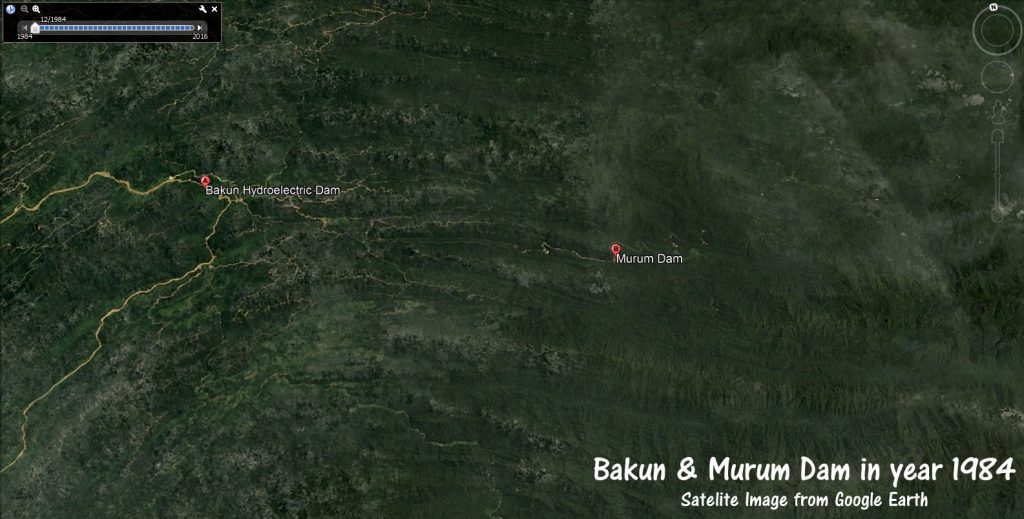
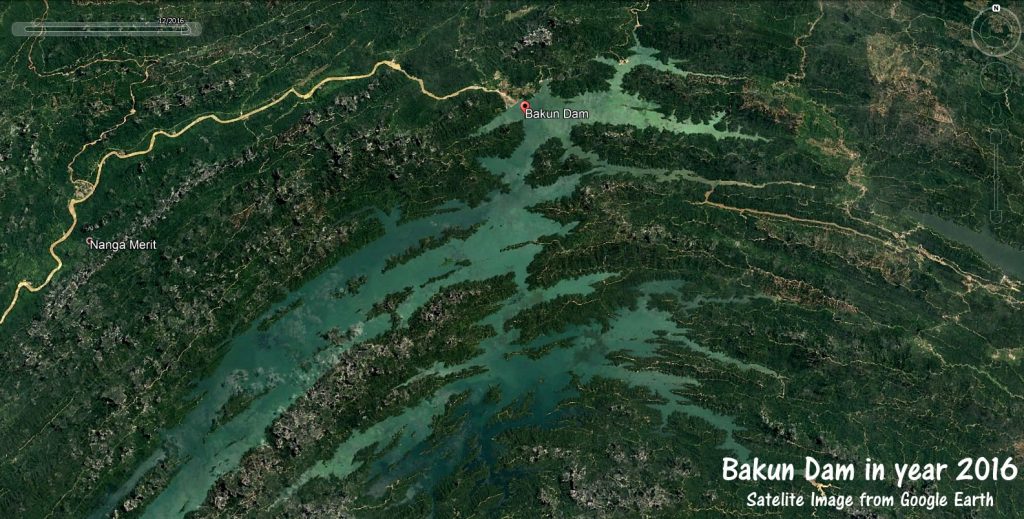
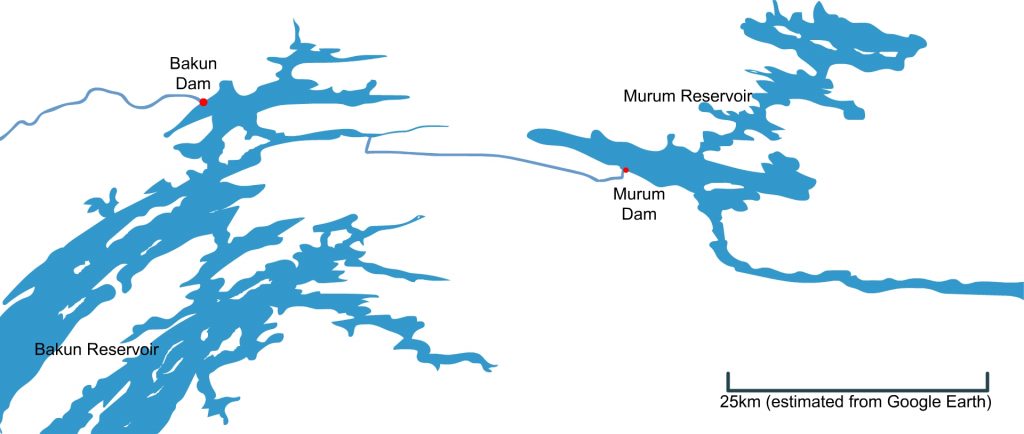
Sarawak have two largest Hydroelectric dams (Bakun and Murum Dam) in Malaysia. The two dams are at the top of the list of Hydroelectric dams in Malaysia, which have the combined power generation capacity more that the total power generated from the others dams in Malaysia combined.
More information about the Hydroelectric dams in Sarawak, Please read our other article : The Two Dams – Bakun VS Murum – and Beyond.
With the completion of another massive dam – Baleh Dam – in Sarawak, it is undeniable that Sarawak is the specialist in Hydroelectric in the region, however it also signify that many precious land mass and forest resource is under water.
The massive reservoir creates opportunity for fresh water fish and prawn aquaculture, however many still unsatisfying with the amount of land under water which can’t be used.
A floating Solar farm can be an alternative answer to the massive reservoir issue. Solar Farm can be build across the larger section of the massive reservoir and forms an alternative power supply to the region or near by villages.

It is part of the quest of greener energy generation where multiple sources are combined to generate a sustainable energy to the region. The sun heats the ground and create raising vapor that forms the cloud. The cloud then cast a rainfall to the natural basin that collects all rain water into the reservoir that forms the potential energy that runs the Hydroelectric turbine. Similarly, the sun light can power up the photovoltaic cells to generate electricity.
Both the Hydroelectric and the Photovoltaic will supply the two different demands of the day. At Daytime, the photovoltaic will function as a power source to meet the Day demand, while at night, the dam reservoir that acts like a battery will supply the electricity at night. Photovoltaic can also be optimised to power up close by village and towns while Hydroelectric will responsible for cities and area further away.
A side note: There is no limitation on tapping on the third source of power from the same place – Methane emission power. Although it is not as green as it is, however Methane gas emission from the biological rich yet oxygen deprivation deep waters of tropical dams have 20 times more green house effect than carbon dioxide alone. Burning off Methane will produce carbon dioxide which is less harmful to environment.
Diversifying Energy Profiles
Electricity is a technology too great to fail. Every time a blackout strikes a city, the whole city will grounded to a halt. Communications fails, transport grounded, Utilities halted, Industrial and Commercial activity ceases, Millions of dollars vaporized and panic starts.
Most of our electrical utility grid is a complex backbone network of energy backups. In Sarawak, we have electricity generated from multiple source, mainly Hydroelectric, Diesel power stations, Combined cycle and open cycle Natural Gas power stations and Coal power plant. However having a Floating Solar Farm will adds into the electricity security of the region.
Beyond the Floating Solar Potentials
Floating Solar Farms, not only been capable to produce clean electrical energy, but also have the potential to combine with other floating technology to expand its capability.
It is all up to your creativity on how to innovate it. The creation is endless.
Some of the ideas are as follows:
- Floating Solar Farm with Aquaculture Farm. The floating solar farm can form a floating structure to hold and enclose your floating fish farm too.
- Floating Solar Farm with artificial coral reefs. Attaching a hollow framework act as a artificial coral reefs below the floating solar farm can allow safe breeding of fishery.
- Floating Solar Farm with seaweed farming. Seaweed farm can be attached to a floating solar farm and why not.
- Floating Solar Farm with advance sensory device. Attaching sensory device across the Floating Solar Farm allows data collection from water temperature, atmospheric pressure changes, water level, water quality and conductivity etc. These data collected from large area across the reservoir will allow complex simulations to predict weather patterns, reservoir volume and even life dynamics in the reservoir.
- Floating Solar Farm with Crypto Mining Rig. It is not impossible to have a underwater crypto currency mining rig, since the large water body can cool down these heat producing machines effectively and the Solar powered will produce unlimited power during day time. Well, this idea don’t benefit those who seek for profit as it will not run during sun down and the high upfront cost don’t provide good return of investment.
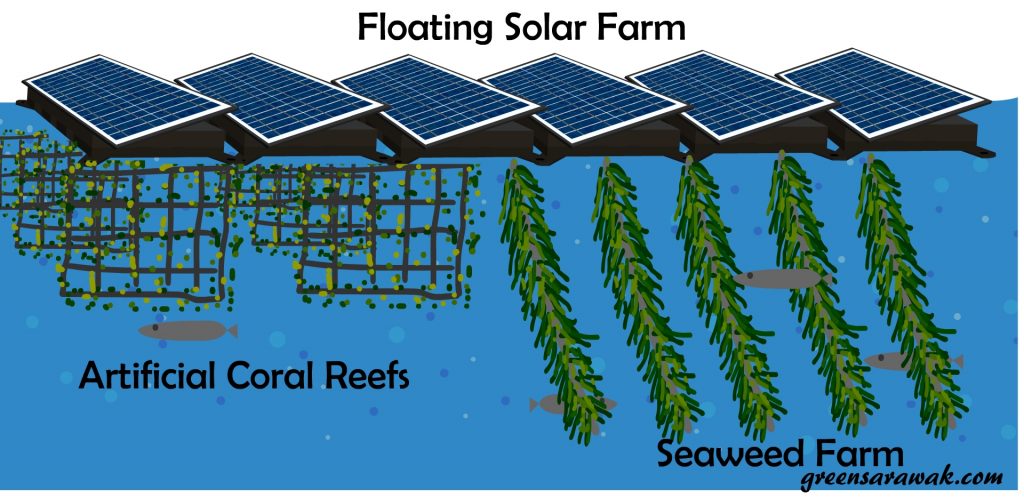
The Conclusion
Floating Solar Farms is a viable technology to be apply in our Hydroelectric Dam Reservoir and Lakes. However there is still many hurdle to pass and many research need to be done to make it an actual implementations in our region.
We are also looking forward for more great green movements around the globe, pioneer by great country such as China, Japan, India, German, and Americans.
The younger generations can take this as a challenge in their quest for green sustainable renewable energy.


